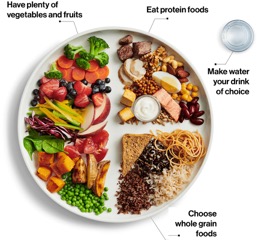This month' guest blog is contributed by Adam Vacon. With over 13 years experience in the developmental services field, Adam has honed his expertise in helping people from all walks of life improve their health through nutrition and healthy living practices. Adam is on a mission to help as many people as possible find optimal health through nutrition. Adam is a certified holistic nutritionist (CNP), certified personal trainer (PTS), and holds a bachelors degree in psychology from McMaster University.
5 Welcome Changes to Canada's Food Guide
1. The New Optimal Food Plate
The new food plate is a great update to The Canada Food Guide, because it features images of actual foods that will be easier for people of all walks of life to understand. I believe this provides people a great image to compare their own dinner plate with so they can easily determine if they’re following the Canada Food Guide or not. From a nutrition stand point I love the emphasis on eating a variety of whole foods each and every day, which will help Canadians get all the nutrients they need to feel their best.
2. An Emphasis on More Plant Foods
Eating more fruits and vegetables is great for our health, plain and simple. Not only is this great for our bodies, but placing a greater emphasis on plant foods can improve the health of our planet by using less energy and producing less waste compared with animal foods. The Government now recommends eating more protein foods that come from plants and I couldn’t agree more. Following these guidelines can lead to getting more vitamins, minerals, antioxidants and fibre in our diets, all of which can help lead to better blood sugar management, a decreased risk of heart disease and healthier bowel movements.
3. Make Water Your Drink of Choice
This is a major win in my opinion. It is clear in this version of the food guide that water is the best drink to consume whereas in the past version it was very easy to inperpret that fruit juices and milk or milk alternatives were on par with water. Water is the most hydrating drink we can consume and is free of sugar found in fruit juices and milk/milk alternatives, which can easily contribute to obesity and diabetes when consumed in excess. Pro tip: If you want to add some flavour to your water add lemons, limes, cucumbers or berries to your glass or pitcher of water!
4. Enjoy Your Food
This is essentially a practice of mindful eating. The Food guide recommends creating an enjoyable experience while eating that includes savouring the flavours and textures of food, choosing foods that are a part of your culture and building a positive eating environment that can involve friendships, music and making a beautiful spread of food. All of these things can help us build a positive association with healthy eating and de-stress from our busy lives.
5. Eat Food With Others
European countries have been practicing this for a long time and I’m glad Canada is getting on board. Creating a habit of eating food with others can help us build new friendships, experience foods from different cultures and try healthy new foods that we may not have tried on our own. We humans are social creatures and bonding with others is just as important to our well being as eating healthy foods. Why not combine two great health practices into one enjoyable experience!
Adam can be reached in the following places:
Individual Services: www.adamvacon.com
Agency Services: www.vaconnutrition.com
Email: adam@vaconnutrition.com
Instagram: @adamvacon
Twitter: @adamvacon






